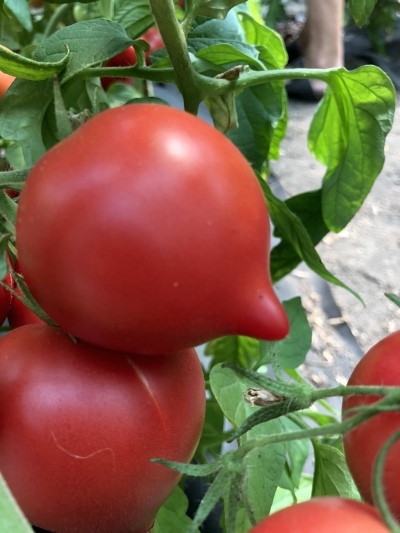
- Authors: Alekseev Y.B. (LLC "Semko-Junior")
- Year of approval: 2008
- Name synonyms: Fifty 50
- Category: hybrid
- Growth type: determinant
- Appointment: fresh consumption, for pickling and canning, for whole-fruit canning
- Ripening period: mid-early
- Ripening time, days: 95-100
- Growing conditions: for open ground, for film greenhouses
- Transportability: good
In pursuit of new varieties or when choosing old, time-tested ones, the intermediate group is often forgotten. Namely: about those plants that appeared 10-25 years ago. And one of the brightest representatives of such cultures is just the tomato Fifty.
Breeding history
This culture was bred at the breeding facilities of Semko-Junior LLC. The main breeder of the project was Yu. B. Alekseev. The official registration of the tomato was made in 2008.
Description of the variety
He also has a quite common synonym - Fifty 50. By its nature, it is a common determinant hybrid. Therefore, it will not amaze with the grandiose height of the bushes - the plant rises only up to 0.6-0.7 m. At the same time, the bushes still grow vigorously, differing in average foliage. The green leaves themselves reach an average size.
The main qualities of the fruit
Tomatoes are initially colored light green. As they ripen, the berries will turn red. Leaving green spots in the area of the stalk is not typical for them. Other features:
the average size;
typical weight 140-150 g;
rounded geometric shape;
sharpening of the top;
laying of the first inflorescence above 5-6 leaves;
laying of subsequent inflorescences every 1-2 leaves;
articulated view of the stalk.
Taste characteristics
The pulp of this tomato is firm. It is divided into a large number of chambers containing seeds. Therefore, the influence of the seeds on the taste is quite large. The smooth skin does not leave any negative impression. Fifty is sweet and harmonious, its fruits are good to use:
in a salad version;
fresh;
when canning;
with other preparations for the winter.
Ripening and fruiting
Fifty is classified as a mid-early tomato. It takes 95-100 days to develop. The countdown for harvesting starts from the emergence of the first greenery. It is worth considering that the plant exhibits such properties only in normal weather and under the condition of competent agricultural technology.
Yield
The collection of berries is quite large. It can reach 10 kg per 1 sq. m. However, in a particular case, the amount strongly depends on meteorological conditions and other factors.
The timing of planting seedlings and planting in the ground
It is necessary to sow planting material in special containers in March. Of course, ordinary boxes can be used instead. Given good growth dynamics, readiness for transplanting into open ground is usually achieved in May. It is necessary to carefully look at the condition of the grown plants and the degree of heating of the earth. It is very important to check that frost does not return suddenly.

Growing tomato seedlings is an extremely important process, because it largely depends on whether the gardener can harvest at all. All aspects must be taken into account, from seedbed preparation to planting in the ground.
Landing scheme
The official supplier of planting material advises adhering to the 700x250 mm system. Yes, it looks strange to many tomato growers. But there is no point in looking for other options.

Growing and caring
Planting is possible both in open gardens and in greenhouses under plastic wrap. Tall greenhouses are not required - in many cases a “film tunnel” is sufficient. Before planting, seeds are advised to be treated not only with potassium permanganate, but also with a growth stimulant. Planting pots are covered with glass or transparent polyethylene. A pick is made when 2 real leaves appear.
A separate container is used for it. Ordinary plastic cups will do. In the last 14 days, plants must be hardened before transferring to open ground. This procedure is carried out for several hours every day. The formation of the second stem is carried out after the laying of 3 or 4 brushes.
Top dressing is laid 4 times per season. Watering is carried out in moderation. It is best done every 5 days. More active irrigation is required only against the background of a dry summer. It is recommended to weed the bushes on rainy days.




A plant needs different micronutrients at each stage of growth. All fertilizers can be divided into two groups: mineral and organic. Folk remedies are often used: iodine, yeast, bird droppings, eggshells.
It is important to observe the rate and period of feeding. This also applies to folk remedies and organic fertilizers.
Disease and pest resistance
Pest resistance is not characterized in the official description. Tomato Fifty has excellent immunity to:
top rot;
cracking berries;
fusarium wilting;
verticillosis;
tobacco mosaic;
bacterial lesions.


Resistant to adverse weather conditions
This variety tolerates heat well. Stress for this plant is also not terrible. But gardeners will only benefit if they exclude such a negative development of events.
Growing regions
Plant a Fifty tomato and then enjoy its wonderful harvest:
in Western Siberia;
in Eastern Siberia;
in the north, center and south of the European part of Russia;
in the Far East region.
Review overview
The gardeners' assessments confirm the high productivity of this variety. Taste expectations are also fully met. The plant is really unpretentious. It can be cultivated successfully for many years. It is noted that the observance of elementary measures of care is quite enough for a decent result.

























































































